Multi-Weather Evaluation of Nowcasting Methods Including a New Empirical Blending Scheme
Abstract
1. Introduction
2. Methodology
2.1. MAPLE and WRF
2.2. Three Blending Schemes
3. Reflectivity Nowcasting Experiments
4. Results
4.1. Spatial Performance for Two Contrasting Events
4.2. Statistical Skill for All the Events
5. Summary and Future Prospect
Author Contributions
Funding
Acknowledgments
Conflicts of Interest
References
- World Meteorological Organization. Manual on the Global Data-Processing and Forecasting System: Annex IV to the WMO Technical Regulations; WMO: Geneva, Switzerland, 2019; p. 148. Available online: https://library.wmo.int/doc_num.php?explnum_id=10164 (accessed on 28 October 2020).
- Sun, J.; Xue, M.; Wilson, J.W.; Zawadzki, I.; Ballard, S.P.; Onvlee-Hooimeyer, J.; Joe, P.; Barker, D.; Li, P.-W.; Golding, B.; et al. Use of NWP for nowcasting convective precipitation: Recent progress and challenges. Bull. Am. Meteorol. Soc. 2014, 95, 409–426. [Google Scholar] [CrossRef]
- Chung, K.-S.; Yao, I.-A. Improving radar echo Lagrangian extrapolation nowcasting by blending numerical model wind information: Statistical performance of 16 typhoon cases. Mon. Weather Rev. 2020, 148, 1099–1120. [Google Scholar] [CrossRef]
- Browning, K.A. Nowcasting; Academic Press: Cambridge, MA, USA, 1982; p. 256. [Google Scholar]
- Cunha, L.K.; Smith, J.A.; Baeck, M.L.; Krajewski, W.F. An early performance evaluation of the NEXRAD dual-polarization radar rainfall estimates for urban flood applications. Weather Forecast. 2013, 28, 1478–1497. [Google Scholar] [CrossRef]
- Huuskonen, A.; Saltikoff, E.; Holleman, I. The operational weather radar network in Europe. Bull. Am. Meteorol. Soc. 2014, 95, 897–907. [Google Scholar] [CrossRef]
- Ligda, M.G.H. The Horizontal Motion of Small Precipitation Areas as Observed by Radar; MIT: Cambridge, MA, USA, 1953; p. 60. [Google Scholar]
- Barclay, P.A.; Wilk, K.E. Severe Thunderstorm Radar Echo Motion and Related Weather Events Hazardous to Aviation Operations; ESSA, Tech. Memo. ERLTM-NSSL 46: Norman, OK, USA, 1970; p. 63. Available online: http://library.nwc.ou.edu/library/reports/OCRd_reports/NSSLtechnicalReport46.pdf (accessed on 28 October 2020).
- Browning, K.A.; Collier, C.G.; Larke, P.R.; Menmuir, P.; Monk, G.A.; Owens, R.G. On the forecasting of frontal rain using a weather radar network. Mon. Weather Rev. 1982, 110, 534–552. [Google Scholar] [CrossRef][Green Version]
- Dixon, M.; Wiener, G. TITAN: Thunderstorm identification, tracking, analysis, and nowcasting—A radar-based methodology. J. Atmos. Ocean. Technol. 1993, 10, 785–797. [Google Scholar] [CrossRef]
- Johnson, J.T.; MacKeen, P.L.; Witt, A.; Mitchell, E.D.; Stumpf, G.J.; Eilts, M.D.; Thomas, K.W. The storm cell identification and tracking algorithm: An enhanced WSR-88D algorithm. Weather Forecast. 1998, 13, 263–276. [Google Scholar] [CrossRef]
- Hering, A.M.; Morel, C.; Galli, G.; Senesi, S.; Ambrosetti, P.; Boscacci, M. Nowcasting thunderstorms in the Alpine region using a radar based adaptive thresholding scheme. In Proceedings of the Third European Conference on Radar Meteorology, Visby, Sweden, 6–10 September 2004. [Google Scholar]
- Jung, S.-H.; Lee, G. Radar-based cell tracking with fuzzy logic approach. Meteorol. Appl. 2015, 22, 716–730. [Google Scholar] [CrossRef]
- Austin, G.L.; Bellon, A. The use of digital weather radar records for short-term precipitation forecasting. Q. J. R. Meteorol. Soc. 1974, 100, 658–664. [Google Scholar] [CrossRef]
- Rinehart, R.E.; Garvey, E.T. Three-dimensional storm motion detection by conventional weather radar. Nature 1978, 273, 287–289. [Google Scholar] [CrossRef]
- Laroche, S.; Zawadzki, I. A variational analysis method for retrieval of three-dimensional wind field from single-Doppler radar data. J. Atmos. Sci. 1994, 51, 2664–2682. [Google Scholar] [CrossRef]
- Li, L.; Schmid, W.; Joss, J. Nowcasting of motion and growth of precipitation with radar over a complex orography. J. Appl. Meteorol. Climatol. 1995, 34, 1286–1300. [Google Scholar] [CrossRef]
- Germann, U.; Zawadzki, I. Scale-dependence of the predictability of precipitation from continental radar images. Part I: Description of the methodology. Mon. Weather Rev. 2002, 130, 2859–2873. [Google Scholar] [CrossRef]
- Bowler, N.E.H.; Pierce, C.E.; Seed, A. Development of a precipitation nowcasting algorithm based upon optical flow techniques. J. Hydrol. 2004, 288, 74–91. [Google Scholar] [CrossRef]
- Ruzanski, E.; Chandrasekar, V.; Wang, Y. The CASA Nowcasting System. J. Atmos. Ocean. Technol. 2011, 28, 640–655. [Google Scholar] [CrossRef]
- Sun, J. Initialization and numerical forecasting of a supercell storm observed during STEPS. Mon. Weather Rev. 2005, 133, 793–813. [Google Scholar] [CrossRef]
- Xiao, Q.; Kuo, Y.-H.; Sun, J.; Lee, W.-C.; Lim, E.; Guo, Y.-R.; Barker, D.M. Assimilation of Doppler radar observations with a regional 3DVAR system: Impact of Doppler velocities on forecasts of a heavy rainfall case. J. Appl. Meteorol. Climatol. 2005, 44, 768–788. [Google Scholar] [CrossRef]
- Xiao, Q.; Sun, J. Multiple-radar data assimilation and short-range quantitative precipitation forecasting of a squall line observed during IHOP_2002. Mon. Weather Rev. 2007, 135, 3381–3404. [Google Scholar] [CrossRef]
- Sun, J.; Zhang, Y. Analysis and prediction of a squall line observed during IHOP using multiple WSR-88D observations. Mon. Weather Rev. 2008, 136, 2364–2388. [Google Scholar] [CrossRef]
- Sugimoto, S.; Crook, N.A.; Sun, J.; Xiao, Q.; Barker, D.M. An examination of WRF 3DVAR radar data assimilation on its capability in retrieving unobserved variables and forecasting precipitation through Observing System Simulation Experiments. Mon. Weather Rev. 2009, 137, 4011–4029. [Google Scholar] [CrossRef]
- Tai, S.-L.; Liou, Y.-C.; Sun, J.; Chang, S.-F.; Kuo, M.-C. Precipitation forecasting using Doppler radar data, a cloud model with adjoint, and the Weather Research and Forecasting model: Real case studies during SoWMEX in Taiwan. Weather Forecast. 2011, 26, 975–992. [Google Scholar] [CrossRef]
- Tsai, C.-C.; Yang, S.-C.; Liou, Y.-C. Improving quantitative precipitation nowcasting with a local ensemble transform Kalman filter radar data assimilation system: Observing system simulation experiments. Tellus A 2014, 66, 21804. [Google Scholar] [CrossRef]
- Yang, S.-C.; Huang, Z.-M.; Huang, C.-Y.; Tsai, C.-C.; Yeh, T.-K. Convective-scale assimilation with the GNSS-ZTD and radar data and its impact on heavy rainfall prediction in Taiwan. Mon. Weather Rev. 2020, 148, 1075–1098. [Google Scholar] [CrossRef]
- Golding, B.W. Nimrod: A system for generating automated very short range forecasts. Meteorol. Appl. 1998, 5, 1–16. [Google Scholar] [CrossRef]
- Cullen, M.J.P. The unified forecast/climate model. Meteor Mag. 1993, 122, 81–94. Available online: https://www.ecmwf.int/en/elibrary/8836-unified-forecast-climate-model (accessed on 28 October 2020).
- Wang, G.; Wong, W.-K.; Hong, Y.; Liu, L.; Dong, J.; Xue, M. Improvement of forecast skill for severe weather by merging radar-based extrapolation and storm-scale NWP corrected forecast. Atmos. Res. 2015, 154, 14–24. [Google Scholar] [CrossRef]
- Hu, M.; Xue, M.; Brewster, K. 3DVAR and cloud analysis with WSR-88D level-II data for the prediction of the Fort Worth, Texas, tornadic thunderstorms. Part I: Cloud analysis and its impact. Mon. Weather Rev. 2006, 134, 675–698. [Google Scholar] [CrossRef]
- Hwang, Y.; Clark, A.J.; Lakshmanan, V.; Koch, S.E. Improved nowcasts by blending extrapolation and model forecasts. Weather Forecast. 2015, 30, 1201–1217. [Google Scholar] [CrossRef]
- Grundland, M.; Vohra, R.; Williams, G.P.; Dodgson, N.A. Cross dissolve without cross fade: Preserving contrast, color and salience in image compositing. Comput. Graph. Forum 2006, 25, 577–586. [Google Scholar] [CrossRef]
- Benjamin, S.G.; Weygandt, S.S.; Brown, J.M.; Hu, M.; Alexander, C.R.; Smirnova, T.G.; Olson, J.B.; James, E.P.; Dowell, D.C.; Grell, G.A.; et al. A North American hourly assimilation and model forecast cycle: The Rapid Refresh. Mon. Weather Rev. 2016, 144, 1669–1694. [Google Scholar] [CrossRef]
- Skamarock, W.C.; Klemp, J.B.; Dudhia, J.; Gill, D.O.; Liu, Z.; Berner, J.; Wang, W.; Powers, J.G.; Duda, M.G.; Barker, D.M.; et al. A Description of the Advanced Research WRF Model Version 4; Technical Note NCAR/TN-556+STR; NCAR: Boulder, CO, USA, 2019; p. 145. [Google Scholar] [CrossRef]
- Yoon, S.-S. Adaptive blending method of radar-based and numerical weather prediction QPFs for urban flood forecasting. Remote Sens. 2019, 11, 642. [Google Scholar] [CrossRef]
- Poletti, M.L.; Silvestro, F.; Davolio, S.; Pignone, F.; Rebora, N. Using nowcasting technique and data assimilation in a meteorological model to improve very short range hydrological forecasts. Hydrol. Earth Syst. Sci. 2019, 23, 3823–3841. [Google Scholar] [CrossRef]
- Malguzzi, P.; Grossi, G.; Buzzi, A.; Ranzi, R.; Buizza, R. The 1966 “century” flood in Italy: A meteorological and hydrological revisitation. J. Geophys. Res. 2006, 111, D24106. [Google Scholar] [CrossRef]
- Metta, S.; von Hardenberg, J.; Ferraris, L.; Rebora, N.; Provenzale, A. Precipitation nowcasting by a spectral-based nonlinear stochastic model. J. Hydrometeorol. 2009, 10, 1285–1297. [Google Scholar] [CrossRef]
- Silvestro, F.; Gabellani, S.; Delogu, F.; Rudari, R.; Boni, G. Exploiting remote sensing land surface temperature in distributed hydrological modelling: The example of the Continuum model. Hydrol. Earth Syst. Sci. 2013, 17, 39–62. [Google Scholar] [CrossRef]
- Robert, A. A stable numerical integration scheme for the primitive meteorological equations. Atmos. Ocean 1981, 19, 35–46. [Google Scholar] [CrossRef]
- Morrison, H.; Thompson, G.; Tatarskii, V. Impact of cloud microphysics on the development of trailing stratiform precipitation in a simulated squall line: Comparison of one- and two-moment schemes. Mon. Weather Rev. 2009, 137, 991–1007. [Google Scholar] [CrossRef]
- Mlawer, E.J.; Taubman, S.J.; Brown, P.D.; Iacono, M.J.; Clough, S.A. Radiative transfer for inhomogeneous atmosphere: RRTM, a validated correlated-k model for the longwave. J. Geophys. Res. 1997, 102, 16663–16682. [Google Scholar] [CrossRef]
- Chou, M.-D.; Suarez, M.J. An Efficient Thermal Infrared Radiation Parameterization for Use in General Circulation Models; NASA, Tech. Memo: Washington, DC, USA, 1994; p. 85.
- Jiménez, P.A.; Dudhia, J.; González-Rouco, J.F.; Navarro, J.; Montávez, J.P.; García-Bustamante, E. A revised scheme for the WRF surface layer formulation. Mon. Weather Rev. 2012, 140, 898–918. [Google Scholar] [CrossRef]
- Chen, F.; Dudhia, J. Coupling an advanced land surface-hydrology model with the Penn State-NCAR MM5 modeling system. Part I: Model implementation and sensitivity. Mon. Weather Rev. 2001, 129, 569–585. [Google Scholar] [CrossRef]
- Hong, S.-Y.; Noh, Y.; Dudhia, J. A new vertical diffusion package with an explicit treatment of entrainment processes. Mon. Weather Rev. 2006, 134, 2318–2341. [Google Scholar] [CrossRef]
- Kain, J.S. The Kain-Fritsch convective parameterization: An update. J. Appl. Meteorol. Climatol. 2004, 43, 170–181. [Google Scholar] [CrossRef]
- Sasaki, Y. An objective analysis based on the variational method. J. Meteorol. Soc. Japan 1958, 36, 77–88. [Google Scholar] [CrossRef]
- Sun, J.; Wang, H.; Tong, W.; Zhang, Y.; Lin, C.-Y.; Xu, D. Comparison of the impacts of momentum control variables on high-resolution variational data assimilation and precipitation forecasting. Mon. Weather Rev. 2014, 144, 149–169. [Google Scholar] [CrossRef]
- Zhang, J.; Howard, K.; Langston, C.; Vasiloff, S.; Kaney, B.; Arthur, A.; Van Cooten, S.; Kelleher, K.; Kitzmiller, D.; Ding, F.; et al. National Mosaic and Multi-Sensor QPE (NMQ) system: Description, results, and future plans. Bull. Am. Meteorol. Soc. 2011, 92, 1321–1338. [Google Scholar] [CrossRef]
- Xin, L.; Reuter, G.; Larochelle, B. Reflectivity-rain rate relationships for convective rainshowers in Edmonton: Research note. Atmos. Ocean 1997, 35, 513–521. [Google Scholar] [CrossRef]
- Wang, Y.; Chandrasekar, V. Quantitative precipitation estimation in the CASA X-band dual-polarization radar network. J. Atmos. Ocean. Technol. 2010, 27, 1665–1676. [Google Scholar] [CrossRef]
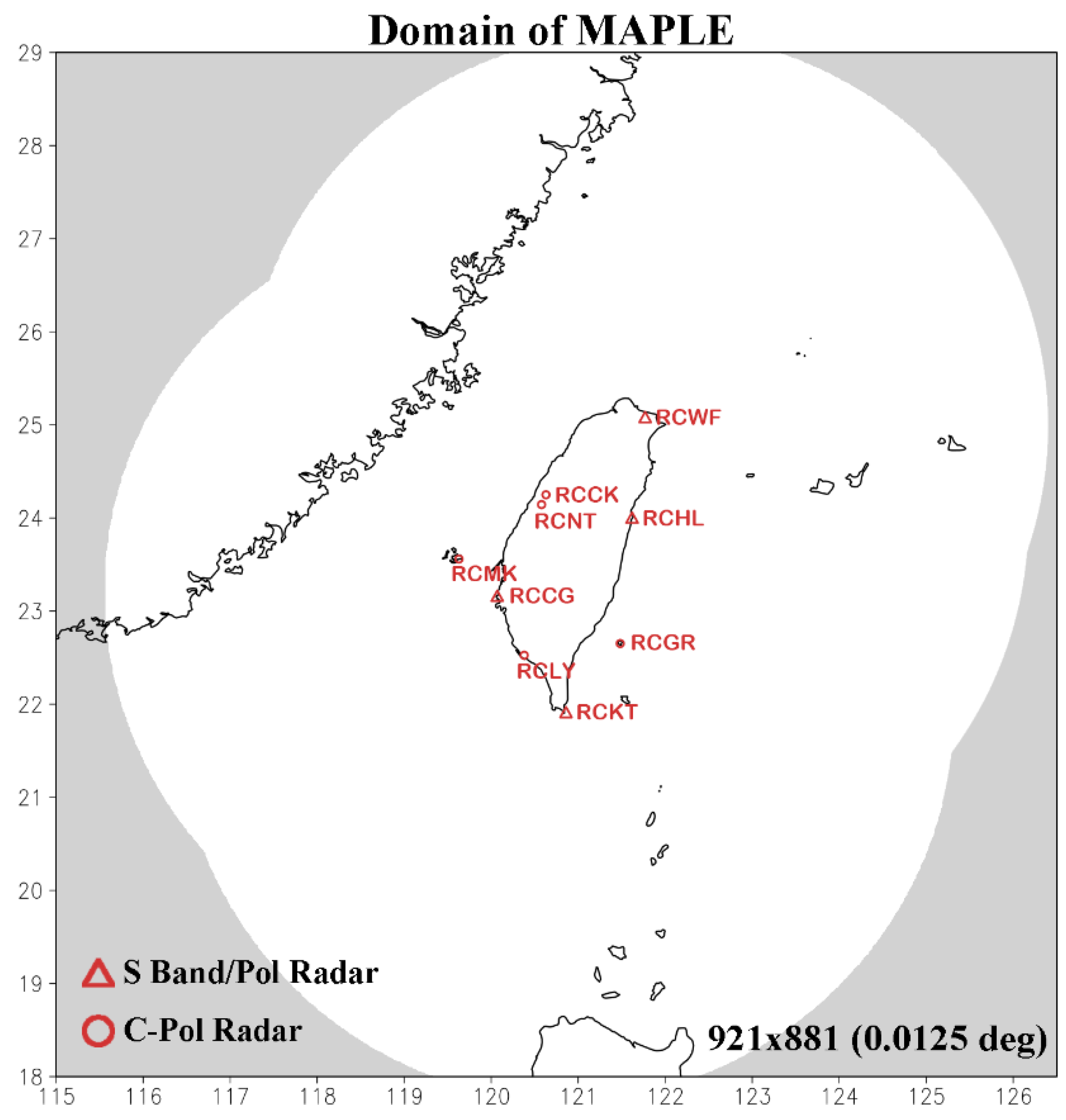
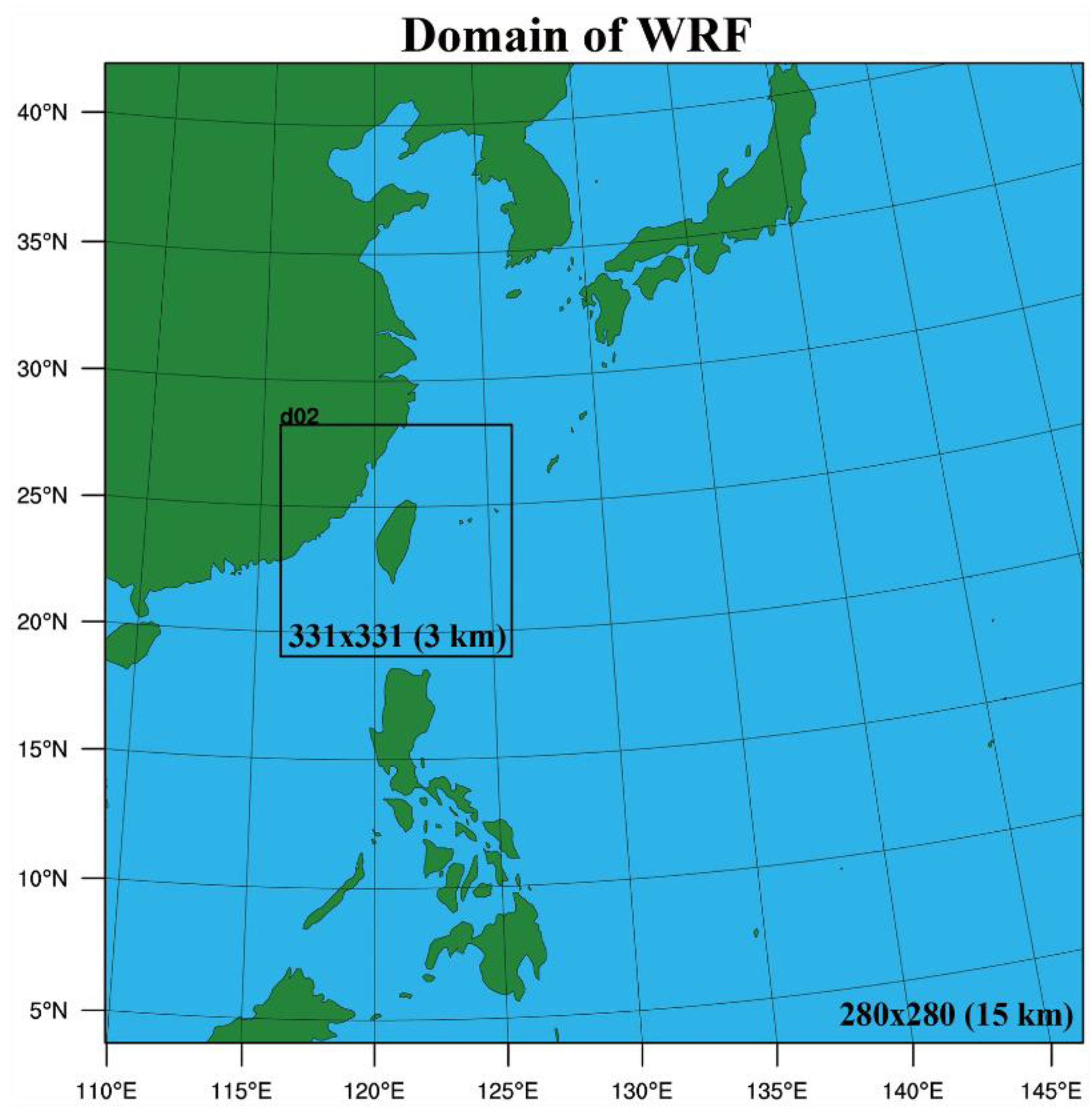


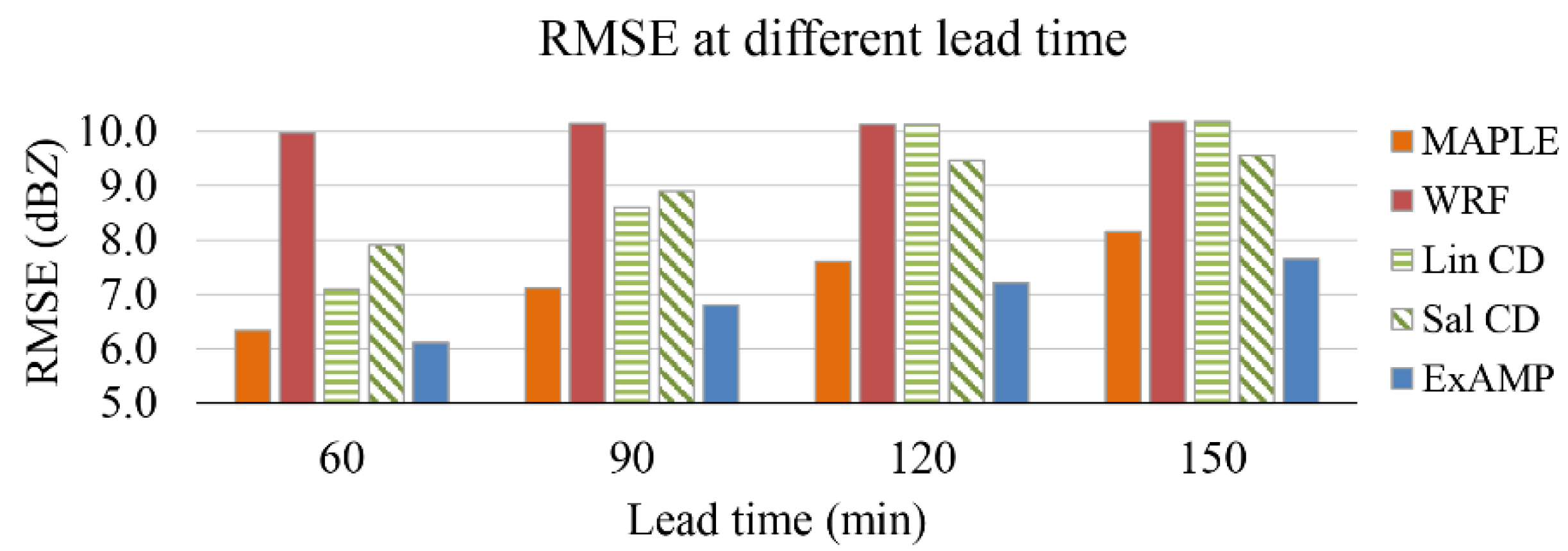


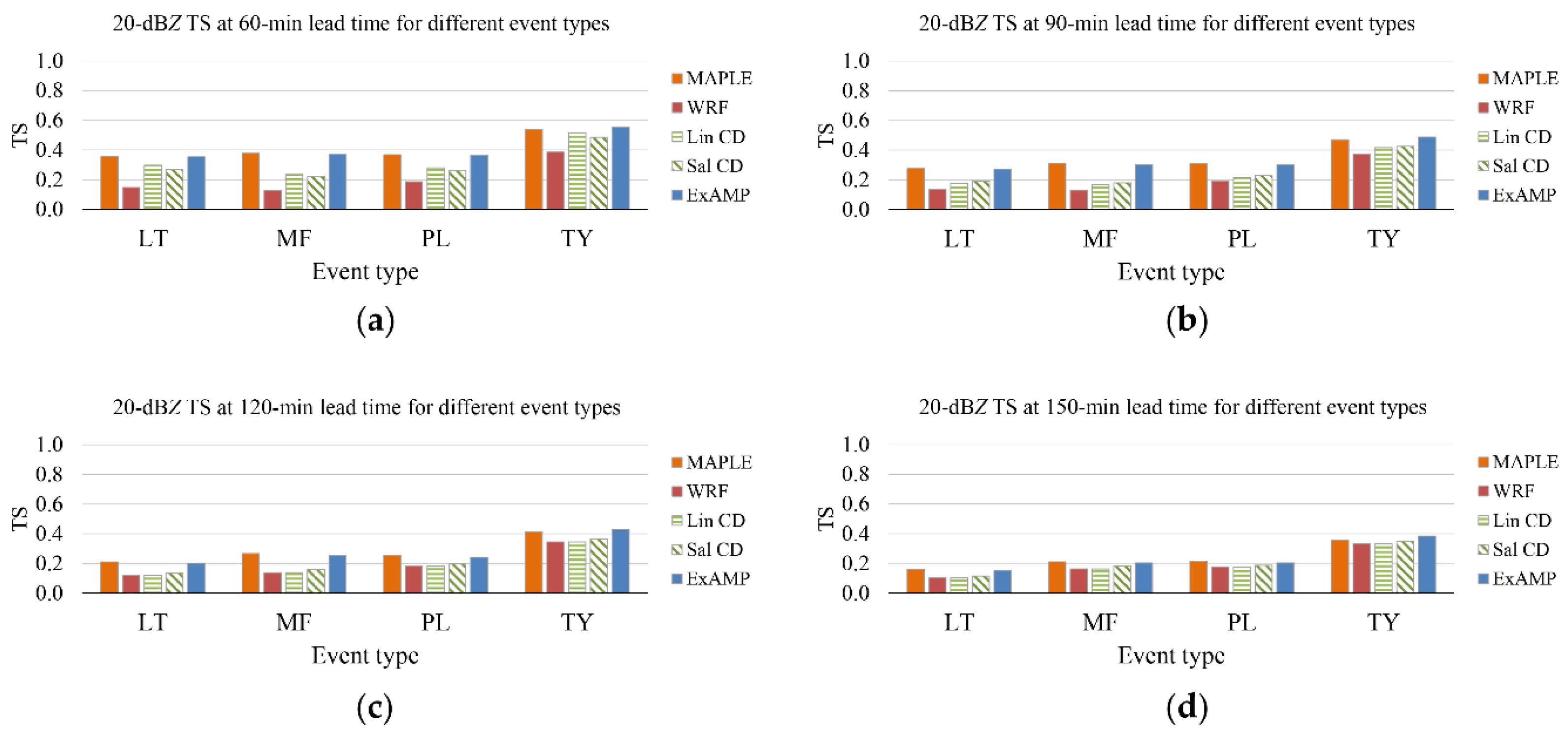
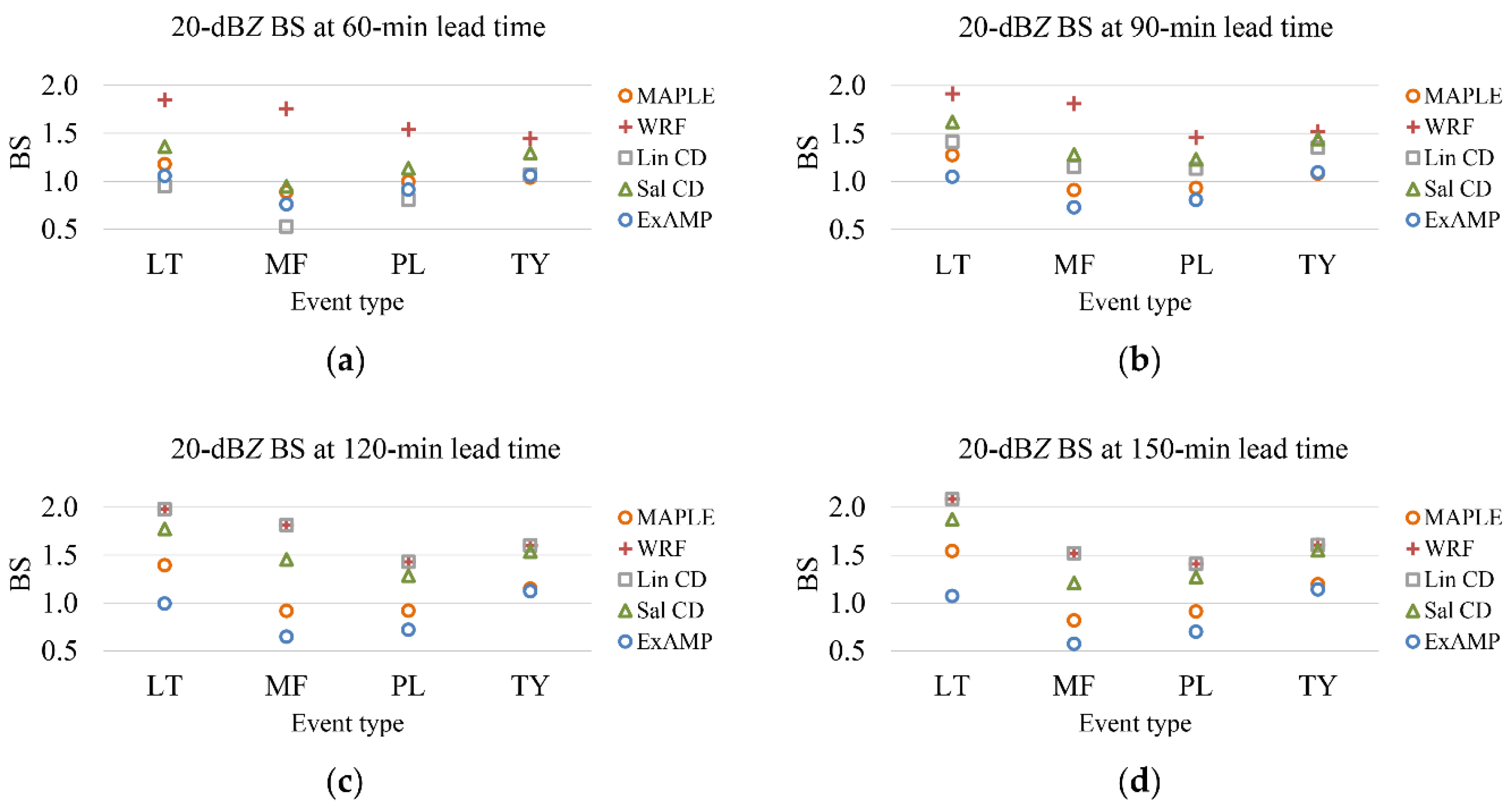
| Event Type | No. of Periods | Event Date |
|---|---|---|
| Local thunderstorm (LT) | 11 | 5/24 (1), 8/1 (5), 8/2 (5) |
| Mei-yu front (MF) | 4 | 5/28 (3), 5/29 (1) |
| Periphery of low pressure (PL) | 19 | 6/11 (3), 6/12 (1), 7/2 (10), 8/6 (5) |
| Typhoon (TY) | 9 | 8/24 (9) |
| Total | 43 | 10 events |
Publisher’s Note: MDPI stays neutral with regard to jurisdictional claims in published maps and institutional affiliations. |
© 2020 by the authors. Licensee MDPI, Basel, Switzerland. This article is an open access article distributed under the terms and conditions of the Creative Commons Attribution (CC BY) license (http://creativecommons.org/licenses/by/4.0/).
Share and Cite
Lin, H.-H.; Tsai, C.-C.; Liou, J.-C.; Chen, Y.-C.; Lin, C.-Y.; Lin, L.-Y.; Chung, K.-S. Multi-Weather Evaluation of Nowcasting Methods Including a New Empirical Blending Scheme. Atmosphere 2020, 11, 1166. https://doi.org/10.3390/atmos11111166
Lin H-H, Tsai C-C, Liou J-C, Chen Y-C, Lin C-Y, Lin L-Y, Chung K-S. Multi-Weather Evaluation of Nowcasting Methods Including a New Empirical Blending Scheme. Atmosphere. 2020; 11(11):1166. https://doi.org/10.3390/atmos11111166
Chicago/Turabian StyleLin, Hsin-Hung, Chih-Chien Tsai, Jia-Chyi Liou, Yu-Chun Chen, Chung-Yi Lin, Lee-Yaw Lin, and Kao-Shen Chung. 2020. "Multi-Weather Evaluation of Nowcasting Methods Including a New Empirical Blending Scheme" Atmosphere 11, no. 11: 1166. https://doi.org/10.3390/atmos11111166
APA StyleLin, H.-H., Tsai, C.-C., Liou, J.-C., Chen, Y.-C., Lin, C.-Y., Lin, L.-Y., & Chung, K.-S. (2020). Multi-Weather Evaluation of Nowcasting Methods Including a New Empirical Blending Scheme. Atmosphere, 11(11), 1166. https://doi.org/10.3390/atmos11111166







